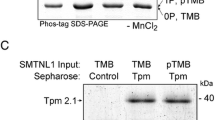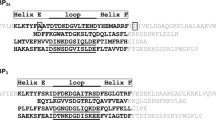Abstract
Calcium is necessary for secretion of pituitary hormones. Many of the biological effects of Ca2+ are mediated by the Ca2+-binding protein calmodulin (CaM), which interacts specifically with proteins regulated by the Ca2+-CaM complex. One of these proteins is myosin light chain kinase (MLCK), a Ca2+-calmodulin dependent enzyme that phosphorylates the regulatory light chains of myosin, and has been implicated in motile processes in both muscle and non-muscle tissues. We determined the content and distribution of CaM and CaM-binding proteins in bovine pituitary homogenates, and subcellular fractions including secretory granules and secretory granule membranes. CaM measured by radioimmunoassay was found in each fraction; although approximately one-half was in the cytosolic fraction, CaM was also associated with the plasma membrane and secretory granule fractions. CaM-binding proteins were identified by an 251-CaM gel overlay technique and quantitated by densitometric analysis of the autoradiograms. Pituitary homogenates contained nine major CaM-binding proteins of 146, 131, 90, 64, 58, 56, 52, 31 and 22 kilodaltons (kDa). Binding to all the bands was specific, Cat+-sensitive, and displaceable with excess unlabeled CaM. Severe heat treatment (100°C, 15 min), which results in a 75% reduction in phosphodiesterase activation by CaM, markedly decreased 251I-CaM binding to all protein bands. Secretory granule membranes showed enhancement for CaM-binding proteins with molecular weights of 184, 146, 131, 90, and 52000. A specific, affinity purified antibody to chicken gizzard MLCK bound to the 146 kDa band in homogenates, centrifugal subcellular fractions, and secretory granule membranes. No such binding was associated with the granule contents. The enrichment of MLCK and other CaM-binding proteins in pituitary secretory granule membranes suggests a possible role for CaM and/or CaM-binding proteins in granule membrane function and possibly exocytosis.
Similar content being viewed by others
References
Samli MH, Geschwind I: Some effects of energy-transfer inhibitors and of Ca2+ free and K+-enhanced media on the release of luteinizing hormone from the rat pituitary gland in vitro. Endocrinology 82:225–231, 1968.
Parsons JA: Effects of cations on prolactin and growth hormone secretion by rat adenohypophyses in vitro. J Physiol 210:973–987, 1970.
Vale W, Burgus R, Guillemin R: Presence of calcium ions as a requisite for the in vitro stimulation of TSH release by hypothalamic TRF. Experientia 23:853–855, 1967.
Tam SW, Danies PS: Dopaminergic inhibition of ionophore A23187-stimulated release of prolactin from rat anterior pituitary cells. J Biol Chem 255:6595–6599, 1980.
Ostlund Jr RE, Leung JT, Hajek SV, Winokur T, Melman M: Acute stimulated hormone release from cultured GH3 pituitary cells. Endocrinology 103:1245–1252, 1978.
Gershengorn MC, Thaw C: Calcium influx is not required for TRH to elevate free cytoplasmic calcium in GH3 cells. Endocrinology 113:1522–1524, 1983.
Albert PR, Tashjian Jr AH: Thyrotropin-releasing hormone-induced spike and plateau in cytosolic free Ca2+ concentrations in pituitary cells. J Biol Chem 259:5827–5832, 1984.
Schlegel W, Wollheim CB: Thyrotropin-releasing hormone increases cytosolic free Ca2+ in clonal pituitary cells (GH3 Cells): Direct evidence for the mobilization of cellular calcium. J Cell Biol 99:83–87, 1984.
Merritt JE, Tomlinson S, Brown BL: Phenothiazines inhibit prolactin secretion in vitro. A possible role for calmodulin in stimulus-secretion coupling in the pituitary. FEBS Lett 135:107–110, 1981.
Schettini G, Judd AM, MacLeod RM: In vitro studies on basal and stimulated prolactin release by rat anterior pituitary: A possible role for calmodulin. Endocrinology 112:64–70, 1983.
Conn PM, Chafouleas J, Rogers D, Means AR: Gonadotropin releasing hormone stimulates calmodulin redistribution in the rat pituitary. Nature 292:264–265, 1981.
Adelstein RS, Eisenberg E: Regulation and kinetics of the actin-myosin-ATP interaction. Ann Rev Biochem 49:921–956, 1980.
Lorenson MY, Lee Y-C, Jacobs LS: Identification and characterization of an anion sensitive Mg2+-ATPase in pituitary secretory granule membranes. J Biol Chem 256:12802–12810, 1981.
Lowry OH, Rosebrough NJ, Farr AL, Randall RJ: Protein measurement with the Folin phenol reagent. J Biol Chem 193:265–275, 1951.
Chafouleas JG, Dedman JR, Munjaal RP, Means AR: Calmodulin: Development and application of a sensitive radioimmunoassay. J Biol Chem 254:10262–10267, 1979.
Nelson TY, Oberwetter JM, Chafouleas JG, Boyd III AE: Calmodulin-binding proteins in a cloned rat insulinoma cell line. Diabetes 32:1126–1133, 1983.
Nelson TY, Snabes MC, Boyd III AE: Measurement of actin and identification of actin- and calmodulin-binding proteins in insulin secreting cells. In: Methods in Diabetes Research. Larner J, Pohl S (eds) J Wiley and Sons, New York, 1984, Vol 1, pp 277–285.
Towbin H, Staehlin T, Gordon J: Electrophoretic transfer of proteins from polyacrylamide gels to nitrocellulose sheets: Procedure and some applications. Proc Natl Acad Sci USA 76:4350–4354, 1979.
Guerriero V, Rowley DR, Means AR: Production and characterization of an antibody to myosin light chain kinase and intracellular localization of the enzyme. Cell 27:448–458, 1981.
Hawkes R, Niday E, Gordon J: A dot-immunobinding assay for monoclonal and other antibodies. Anal Biochem 119:142–147, 1982.
Zar JH: Biostatistical analysis, 2nd ed, Prentice-Hall, Inc, Englewood Cliffs, NJ, 1984, p 162.
Beale EG, Dedman JR, Means AR: Isolation and regulation of the protein kinase inhibitor and the calcium-dependent cyclic nucleotide phosphodiesterase regulator in the sertoli cell-enriched testis. Endocrinology 101:1621–1634, 1977.
Linden CD, Dedman JR, Chafouleas JG, Means AR, Roth TF: Interactions of calmodulin with coated vesicles from brain. Proc Natl Acad Sci USA 78:308–312, 1981.
Grab DJ, Berzins K, Cohen RS, Siekevitz P: Presence of calmodulin in postsynaptic densities isolated from canine cerebral cortex. J Biol Chem 254:8690–8696, 1979.
Burgoyne RB, Giesow MJ: Specific binding of 125I-calmodulin to and protein phosphorylation of adrenal chromaffin granule membranes. FEBS Lett 131:127–131, 1981.
Grinstein S, Furuya W: Binding of 125I-calmodulin to platelet alpha-granules. FEBS Lett 140:49–52, 1982.
Watkins D, White BA: Identification and characterization of calmodulin-binding proteins in islet secretory granules. J Biol Chem 260:5161–5165, 1985.
Goewert RR, Klaven NB, McDonald JM: Direct effect of insulin on the binding of calmodulin to rat adipocyte plasma membranes. J Biol Chem 258:9995–9999, 1983.
Hooper JE, Kelly RB: Calcium-dependent calmodulin binding to cholinergic synaptic vesicles. J Biol Chem 259:141–147, 1984.
Hooper JE, Kelly RB: Calmodulin is tightly associated with synaptic vesicles independent of calcium. J Biol Chem 259:148–153, 1984.
Steinhardt RA, Alderton JM: Calmodulin confers calcium sensitivity on secretory exocytosis. Nature 295:154–155, 1982.
Carlin RK, Grab DJ, Siekevitz P: Function of calmodulin in postsynaptic densities III calmodulin-binding proteins of the post synaptic density. J Cell Biol 89:449–455, 1981.
Glenney JR, Weber K: Calmodulin-binding proteins of the microfilaments present in isolated brush borders and microvilli of intestinal epithelial cells. J Biol Chem 255:10551–10554, 1980.
Giesow MJ, Burgoyne RD: Recruitment of cytosolic proteins to a secretory granule membrane depends on Ca2+-calmodulin. Nature 301:432–435, 1983.
Rubin RW, Lyubkin AK, Pressman BC: Comparison of the protein content of 3 different bovine secretory granule membrane types: A search for exocytosis-specific shared proteins. J Cell Biol 99:356–360, 1984.
Watkins DT, Cooperstein SJ: Role of calcium and calmodulin in the interaction between islet cell secretion granules and plasma membranes. Endocrinology 112:766–768, 1983.
Cohen P, Burchell A, Foulkes JG, Cohen PTW, Vanaman TC, Nairn AC: Identification of the Ca2+ -independent modulator protein as the fourth subunit of rabbit skeletal muscle phosphorylase kinase. FEBS Lett 92:287–293, 1978.
Means AR, Tash JS, Chafouleas JG: Physiological implications of the presence, distribution, and regulation of calmodulin in eukaryotic cells. Physiological Reviews 62:1–39, 1982.
Author information
Authors and Affiliations
Rights and permissions
About this article
Cite this article
Nelson, T.Y., Lorenson, M.Y., Jacobs, L.S. et al. Distribution of calmodulin and calmodulin-binding proteins in bovine pituitary: association of myosin light chain kinase with pituitary secretory granule membranes. Mol Cell Biochem 74, 83–94 (1987). https://doi.org/10.1007/BF00221915
Received:
Issue Date:
DOI: https://doi.org/10.1007/BF00221915




